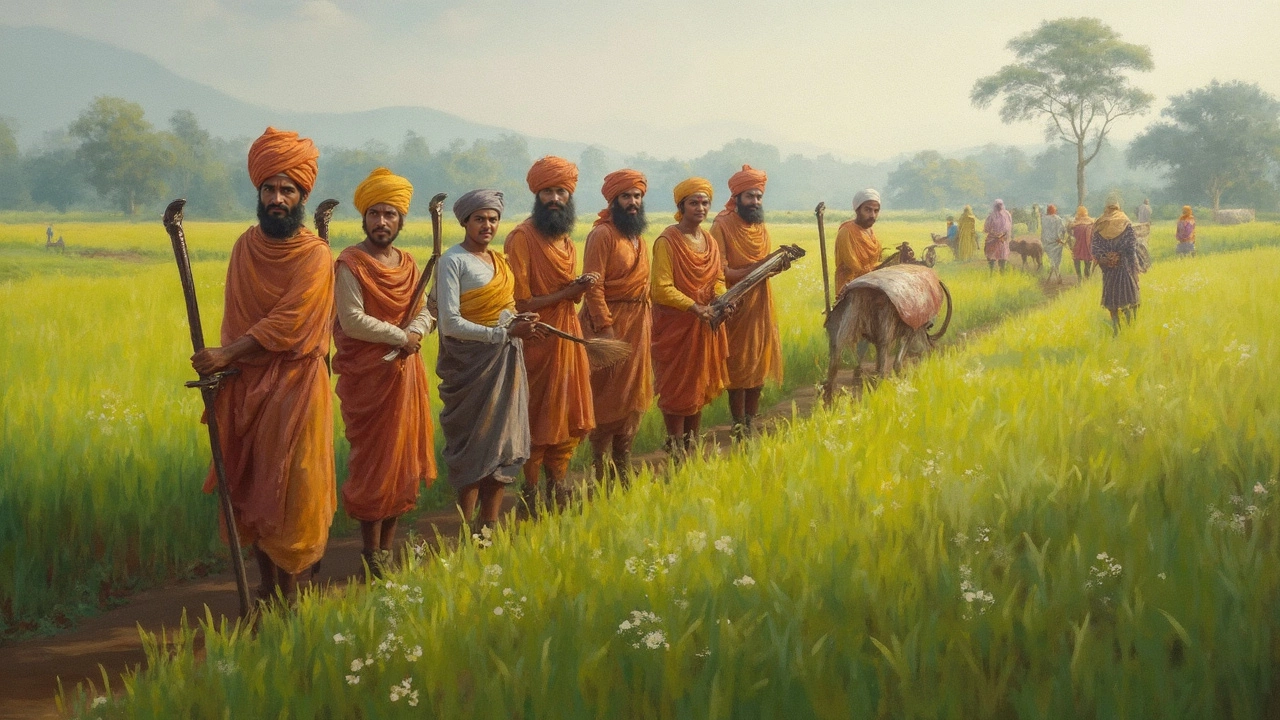Ever wondered why Sikhs carry a Kirpan? It's not just about having a knife or weapon. The Kirpan is steeped in history and spirituality, symbolizing Sikh values like justice, courage, and protecting the weak. Dating back to the 17th century, it was introduced by Guru Gobind Singh, the tenth Sikh Guru, during a time of turmoil to uphold righteousness and freedom.
But let's clear up any confusion right from the start. The Kirpan isn't an offensive weapon—it’s a spiritual and ceremonial item for initiated Sikhs, also known as Amritdhari Sikhs. Forget what you've seen in movies: the Kirpan isn't meant for violence or aggression. Instead, it's a reminder of one's duty to stand up against injustice and help those in need, embodying the Sikh principle of ‘Sant-Sipahi’ – a saint and soldier.
- Introduction to the Kirpan
- Historical Significance
- Kirpan and Sikh Values
- Modern Relevance
- Common Misconceptions
- Practical Insights
Introduction to the Kirpan
The Kirpan isn't just a piece of armor or a fashion statement—it's a fundamental aspect of Sikhism. At its core, the Kirpan is a ceremonial dagger that initiated Sikhs, known as Khalsa Sikhs, carry. While it may resemble a weapon, its true purpose is symbolic.
Historically, the Kirpan dates back to the early 18th century when it was formalized by Guru Gobind Singh, the tenth Guru of Sikhs. He introduced the Kirpan as a part of the 'Five Ks'—a set of five articles of faith that Sikhs wear at all times to show their dedication to their faith. Imagine it like a uniform that represents their spiritual commitment and readiness to protect the rights of others.
But what does the Kirpan really represent? It's more than just a symbol. The Kirpan stands for the Sikh values of justice, dignity, and honesty. Its literal meaning is 'grace and honor'—an embodiment of self-sacrifice, courage, and compassion. Sikhs believe in using the Kirpan to fight against oppression and support the oppressed, but this fight is rooted in non-violence and moral righteousness.
Common Features of a Kirpan
- Blade length typically ranges from 3 to 12 inches.
- Often adorned with intricate designs and engravings.
- Carried in a sheath and usually worn strapped across the body.
Understanding the Kirpan involves recognizing its deep connection to Sikh identity and values. It emphasizes the responsibility of Sikhs to live truthful lives, committed to protecting the downtrodden without resorting to aggression.
Historical Significance
The Kirpan carries with it a rich legacy that began in the late 1600s. It was during this era that Guru Gobind Singh, a pivotal figure in Sikhism, introduced the Kirpan along with the other four K's that form an integral part of Khalsa identity. This step was driven by the chaos and persecution Sikhs faced, where standing up against oppression was not just encouraged, it was necessary.
Imagine living in a time where religious freedom wasn't a given. The Khalsa Panth, or collective body of initiated Sikhs, was born with the intent to protect and serve. The Kirpan, with its very design, symbolizes a commitment to that cause. Drawing from the tradition of warriors and saints, Guru Gobind Singh's idea was clear: Sikhs were to embody both the spiritual and the soldier’s virtues.
But don't just look at the Kirpan as a relic of the past. Even today, it stands as a testament to historical resilience and the fight for justice. Throughout the years, the Kirpan has maintained its place in ceremonies and personal life, echoing its historical roots in every use and symbolizing the timeless Sikh values.
| Period | Event |
|---|---|
| 1699 | Guru Gobind Singh introduces the Khalsa and the five K's, including the Kirpan. |
| 1700s | Sikhs undergo significant persecution, strengthening the Kirpan's role as a symbol of defense and justice. |
| 1849 | After annexation of Punjab, British authorities attempt to limit the carry of Kirpans. |
Kirpan and Sikh Values
The Kirpan isn't just about carrying a small sword; it's about embodying core Sikh values that have shaped the identity of Sikhs for centuries. One key principle here is justice. In Sikhism, standing up against tyranny and oppression is non-negotiable. The Kirpan serves as a constant reminder of the individual's duty to protect the innocent and promote fairness in society.
Commitment to Spirituality
Beyond its physical form, the Kirpan symbolizes a deep commitment to spirituality. It's more about inner strength than external prowess. Sikhs believe in leading a life where one's actions consistently reflect their spiritual beliefs, and the Kirpan helps maintain this focus. It reminds the bearer to lead by example, nurturing inner peace and practicing what they preach.
Courage and Defense
Courage is another pillar that the Kirpan represents. But we're not talking reckless bravery here. It's about having the guts to speak up for what's right, even when it's not easy. While the Kirpan is a defensive tool, it's primarily a symbol of readiness to defend those who cannot protect themselves.
Equality and Humility
Sikhism is big on equality and humility, and the Kirpan reinforces these values. This item is not a status symbol but a tool for service. Every Sikh is equal, regardless of social standing, and carries the same responsibility to uphold these shared values, offering help and support whenever needed.
These principles show how the Kirpan goes beyond being just a ceremonial object. It’s a part of everyday life for many Sikhs, a guiding force that keeps them aligned with their values. It’s these aspects that make it more than a relic; it's an active guide for the followers of Sikhism.

Modern Relevance
Ever bumped into someone wearing a Kirpan and wondered about its place in today’s world? While the Kirpan is over three centuries old, it seamlessly integrates into modern life, holding its ground amid changing times. For Sikhs, it's not just a relic of the past, but a living expression of their values.
Many Sikhs continue to carry their Kirpan daily. It's a part of their identity and journey—symbolizing the ongoing fight against social injustices in contemporary society. In schools, workplaces, and public spaces, discussions around the Kirpan often lead to valuable dialogues about diversity, religious freedom, and understanding cultures better.
The Legal Landscape
The Kirpan sometimes stirs debates in legal circles, especially concerning safety and security. Different regions have different ways of accommodating this practice while respecting security protocols. For instance, in Canada, the legal system allows wearing a Kirpan in public places, including airplanes, with certain conditions to ensure it doesn't pose any risk.
Bridging Cultures
Beyond the legal framework, the Kirpan stands as a bridge across cultures, fostering understanding and empathy. Schools and communities have launched educational initiatives to demystify the Kirpan and enlighten others on its symbolic significance, promoting inclusivity.
Striking a Balance
Yes, it might seem challenging to balance tradition with modern demands, but Sikh communities are thriving, adapting to these changes while retaining core values that the Kirpan embodies. It’s a beautiful balancing act of preserving heritage in our fast-moving world. Not just a symbol, but an enduring commitment to peace, justice, and personal integrity.
Common Misconceptions
When it comes to the Kirpan, there are quite a few myths floating around. Let's set the record straight.
Not a Weapon of Aggression
One of the biggest misconceptions is that the Kirpan is a weapon like any other knife or dagger. In reality, it's a religious symbol worn by Sikhs who have undergone the Amrit initiation. The Kirpan is about duty and justice, not harm and aggression.
Size and Appearance
Some folks are surprised to learn that the Kirpan doesn't have a standard size. Whether it's a few inches or several feet long, the size isn’t what's important. It's the principle it stands for, which is why many Sikhs wear a small Kirpan as part of their daily attire.
Legal Context
People often wonder about the legality of carrying a Kirpan, especially in places with strict weapon regulations. Most countries with Sikh populations have exemptions for carrying a Kirpan due to its religious significance. However, it's always wise for Sikhs to be aware of local laws and, if required, explain the Kirpan's context and purpose.
Not Just for Men
Another misconception is that only Sikh men wear the Kirpan. Women who have taken the Amrit vows also carry it as part of their faith, debunking any notion that the Kirpan is gender-specific.
Symbolism Over Physical Form
It's easy for onlookers to see the Kirpan solely as a physical object. Yet, it embodies deeper values like compassion, honesty, and the duty to do what’s right, making it a pillar of Sikh identity rather than just an accessory.
By understanding these common misconceptions, we can appreciate the Kirpan more deeply—not just as a religious symbol, but as a representation of core Sikh values.
Practical Insights
Let's get a bit more hands-on with understanding how the Kirpan is integrated into the daily lives of Sikhs. Firstly, you might wonder how feasible it is to carry this item regularly. Well, the Kirpan is often worn under clothes using a strap, known as a Gatra, ensuring it’s always close to the body but securely fastened.
Everyday Life and the Kirpan
Wearing a Kirpan can seem challenging, especially in places with strict security like airports. Yet, many countries, including Canada and the UK, have made special allowances for Sikhs to carry it, recognizing its cultural and religious significance. For Sikhs, not carrying the Kirpan would be like leaving a part of their spiritual identity at home.
Practical Tips for Sikhs
- Always check local laws and guidelines regarding the carrying of the Kirpan when traveling or attending events.
- For those new to wearing a Kirpan, starting with a smaller, more manageable version might be practical till they get accustomed to it.
- Seek advice from a community leader if you face challenges or discrimination while carrying it.
Cultural Sensitivity and Education
For non-Sikhs, understanding the Kirpan is crucial for fostering inclusivity. Simple acts like asking questions respectfully can go a long way. Awareness campaigns in schools and workplaces have been effective in breaking down barriers and myths about the Kirpan.
If you're interested in delving deeper, community events like open Gurdwara days offer a first-hand experience to learn about the significance of the Kirpan and other Sikh practices.



